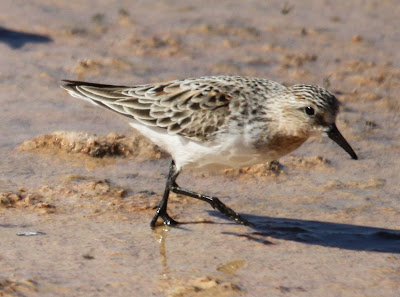The idea of yet another visit to
Port Gregory was quickly seen to be well founded when arriving at the
pools to find them 'awash' with small Waders. Not the Stints of a couple
of days ago, but just as welcome
RED-CAPPED PLOVERI think at this point we can let the pictures do most of the talking:-
While no accurate count was made, it would be safe to say there were in excess of 200 adults here,
and despite this being the winter months many were already vigorously displaying.
Juveniles were also well represented with at least 50 individuals.
Let's
take a closer look at that wing action again. Time to move on, and back
to the Pink Lagoon where again the luck seemed to be holding.
A
long way off and shimmering in the pink bloom, at least some of the
Avocets were in attendance today, but even with the 'scope no Stilts
could be seen. The wait was short, as suddenly this small flock took to
the air and landed within the Salt Pan, fortunately a little closer.
Have just noticed after publishing that the full width of these wider shots cannot be seen. 'Right click' on image to see full shot.
With just binoculars, now c2 BANDED STILT could be seen (6th bird from each end at front)
endorsing the World Lifer status - YES! Having savoured that moment, there was more to come as a lone
RED-KNEED DOTTEREL flew in to join the throng. Middle distance at first, but slowly and surely it seemed to gain confidence
and closed to just a few metres.
That
is when I had to temporally give up on it as these 4 Stint were
suddenly right before me feeding on the mud. Each in a different state
of plumage
added a degree of difficulty to deciding if more than one species was involved here.
Eventually
RED-NECKED STINT was thought most likely though I did consult with
those in UK (more knowledgeable than I) just to confirm.
By now the Dotterel was all but underfoot, and what a smart chap,
and pushing the luck even further decided on a little Manual Focus practiseon this flying DRAGONFLY.
It
would have been foolhardy not to stop at the Pools on the return
journey, where it was found most of the Waders were gone only to be
replaced by these 2 fine looking
AUSTRALIAN SHELDUCK



























No comments:
Post a Comment